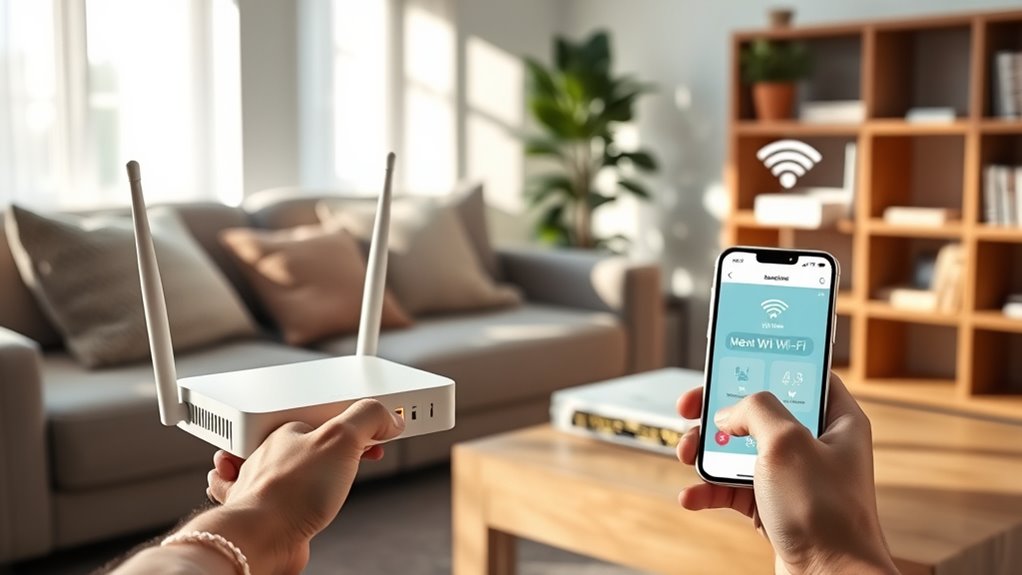To set up a mesh Wi-Fi system at home, start by placing your main router near your modem in a central, open area for the best coverage. Then, position satellite nodes where signals are weak but still within range of the main router, testing their placement with a Wi-Fi analyzer. Guarantee nodes stay within a few rooms of each other for seamless coverage. Keep security settings updated and perform speed tests to optimize performance. If you follow these steps, you’ll achieve reliable Wi-Fi throughout your home.
Key Takeaways
- Place the main router near the modem in a central, open location for optimal coverage.
- Position satellite nodes within range of the main router and in areas with weak Wi-Fi signals.
- Use Wi-Fi analyzers or devices to test signal strength and identify the best node placement spots.
- Enable WPA3 encryption and set strong passwords to secure your network and guest access.
- Regularly update firmware, test network performance, and adjust node placement for consistent coverage.

Setting up a mesh Wi-Fi system is straightforward and can substantially improve your home’s internet coverage. The key to a smooth setup lies in strategic router placement, ensuring each node communicates effectively without dead zones. When positioning your mesh units, think about your home’s layout. Place the main router near your modem, ideally in a central location, to maximize coverage. Avoid placing it inside cabinets or behind thick walls, which can hinder signal strength. The goal is to have the primary node in an open area, free from obstructions, so it can distribute Wi-Fi signals efficiently. As for the satellite nodes, position them in areas where your signal is weak but still within a good range of the main router. This might mean moving them around a bit, testing signal strength with your smartphone or a Wi-Fi analyzer app until you find the essential spots. Proper router placement reduces dead zones and guarantees seamless roaming throughout your home.
Beyond coverage, setting up your mesh system with strong network security is vital. Once you’ve placed your units, access the system’s app or web interface to configure security features. Change the default administrator password to something strong and unique, preventing unauthorized access. Enable WPA3 encryption if your system supports it; this provides the latest security standards and better protects your network from potential threats. Additionally, set a robust Wi-Fi password that isn’t easily guessable. Consider creating a separate guest network for visitors, so they can access the internet without gaining access to your main devices and personal data. Regularly updating your mesh system’s firmware is also imperative, as updates often include security patches that safeguard your network against vulnerabilities. Maintaining proper device placement and security practices ensures optimal performance and protection for your network.
As you finalize your setup, double-check that your mesh units are placed in locations where they can communicate reliably. A good rule of thumb is to ensure each node is within a few rooms’ distance of the others, avoiding physical barriers like thick walls or large furniture that can weaken signals. Once everything is in place, run a speed test in different parts of your home to confirm coverage and performance. Remember, the key to a reliable, secure Wi-Fi network isn’t just in the initial setup but ongoing maintenance. Keep your firmware up to date, monitor your network for unusual activity, and adjust your router placement if you notice slowdowns or dead zones. With these steps, you’ll enjoy a fast, stable, and secure mesh Wi-Fi system tailored to your home’s needs.
Frequently Asked Questions
How Many Mesh Nodes Do I Need for My Home Size?
You’ll likely need 3 to 4 mesh nodes for your home, depending on its size and layout. Place your router centrally to maximize signal range, then position additional nodes in areas where the signal weakens. Proper router placement guarantees strong coverage throughout your home. Consider walls and obstacles that may block signals, and adjust node placement accordingly to maintain seamless connectivity across all rooms.
Can I Use a Mesh Wi-Fi System With My Existing Router?
Yes, you can use a mesh Wi‑Fi system with your existing router, but check the router’s compatibility first. Many mesh systems support network integration with standard routers, allowing seamless connectivity. Make sure your current router has open Ethernet ports for ideal setup, and verify if the mesh system is compatible with your router’s network standards. This way, you’ll create a unified, strong Wi‑Fi network throughout your home.
What Is the Typical Cost of a Mesh Wi-Fi System?
A typical mesh Wi-Fi system costs between $150 and $400, depending on the coverage area and features. You should consider your budget and the size of your home when exploring pricing options. More affordable models are suitable for smaller spaces, while higher-end systems offer extended coverage and advanced features. Comparing different brands and packages helps you find a mesh Wi-Fi system that fits your needs and budget considerations.
How Do I Troubleshoot Connectivity Issues With My Mesh Network?
If you notice connectivity issues with your mesh network, start by checking for signal interference from other devices or obstacles. Restart your router and nodes, and make sure firmware updates are current—these often fix bugs and improve performance. If problems persist, reposition the nodes for better coverage, and minimize interference sources. Regular maintenance like firmware updates and strategic placement can keep your mesh system running smoothly.
Do Mesh Wi-Fi Systems Support Smart Home Devices?
Yes, mesh Wi-Fi systems support smart home devices, ensuring smart home compatibility. You can connect your smart lights, thermostats, and security cameras seamlessly. Many systems also let you prioritize specific devices, like your smart hub, to improve performance. Just check your mesh system’s app for device prioritization options and compatibility details, so your smart home devices work smoothly alongside your Wi-Fi network.
Conclusion
Setting up your mesh Wi-Fi system is like planting seeds for a thriving digital garden, spreading strong, seamless coverage throughout your home. With a few simple steps, you’ll create a reliable network that blooms with speed and stability. Just remember, patience is your water; nurture your setup, and watch your connection grow into a lush, interconnected landscape—where every device finds its place and your online experience flourishes effortlessly.









